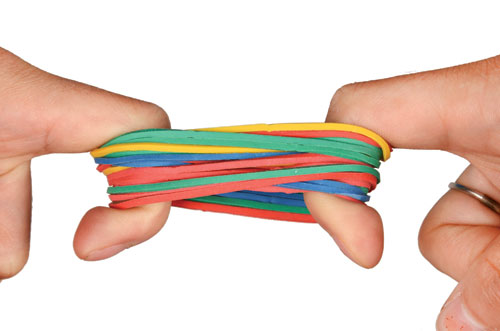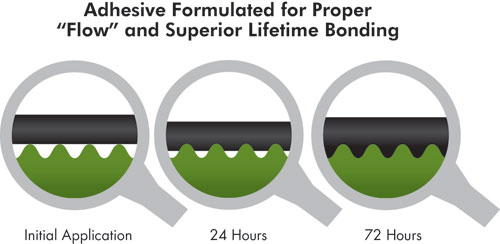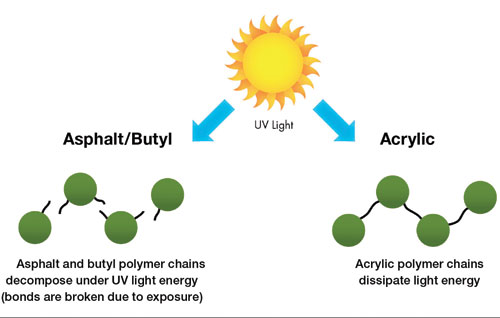Acrylic Flashing Tape Keeps It Together
Acrylic Tape—Why It Works
Acrylic tapes perform well as a result of several contributing factors.
Viscoelasticity
This term refers to having viscous as well as elastic properties when deformed. Viscous behavior of a material can be imagined as the way in which honey responds to stress from gravity. When honey is poured from a vessel, it moves slowly. That is because internal stresses between molecules increase with relative velocity between molecules. The faster the molecules move, the greater is the resistance to that movement. The less viscous the fluid is, like water, the greater its ease of movement. The reverse is true for thicker or more viscous materials. Elasticity is a property of materials that return to their original shape after deformation.
 |
Photo courtesy of Huber Engineered Woods |
 |
Photo courtesy of Huber Engineered Woods |
 |
Illustration courtesy of Huber Engineered Woods |
Because acrylic adhesive is viscoelastic, it acts simultaneously as both a liquid (viscous) and solid (elastic). Its viscous properties allow it to flow into small surface cracks and abnormalities to form a strong bond. Its elastic nature means it possesses the adhesive strength necessary to preserve the bond. In other words, viscoelastic materials exhibit traits of both liquids and solids and enable superior initial adhesion, as well as the ability to dissipate stresses and resist compression, deformation, and flattening. Viscoelastic tapes are widely considered to be engineered for long-term jobsite performance.
Tape Construction
Each layer of acrylic tape is engineered for functionality. The illustration on the left is an example of how one type of advanced acrylic tape is constructed. The top layer provides tack for safety. A thick inner layer provides dimensional stability, weather and UV protection, with darker shades being the preferred color for sunscreen and containing sufficient antioxidants for durability. A thin bottom layer is formulated to bond with the adhesive layer.
Heat and UV Resistant
Heat and ultraviolet light are two key factors that degrade tape life. The acrylic adhesive in some tapes resists heat and UV sunlight far better than butyl and asphalt. Cross-linked polymer chains create extremely strong molecular bonds that withstand a much wider range of temperatures. In addition, they dissipate light energy, which can break the bonds in asphalt and butyl. Even in severe conditions, certain acrylic tapes retain superior adhesion strength for years. Rigorous durability tests have been developed to test tape against exposure to these factors. Accelerated aging tests simulate a “worst-case scenario” in terms of exposure to heat and UV over time. For example, some accelerated aging tests can be equivalent to 180 days initial exposure and then 30 years as a roof underlayment in Miami, Florida. Architects are well advised to consult the warranty terms for tape products. Some manufacturers are so confident in the long-term performance of their tape that they warrant it up to 30 years.
 |
Illustration courtesy of Huber Engineered Woods |
Accommodation of Wall Characteristics
Some advanced acrylic tapes are designed to accommodate the normal expansion and contraction of walls. These acrylic tapes can adjust with a home over its lifetime, as some can flex and stretch up to 800 percent to accommodate the normal contraction and expansion of walls.









